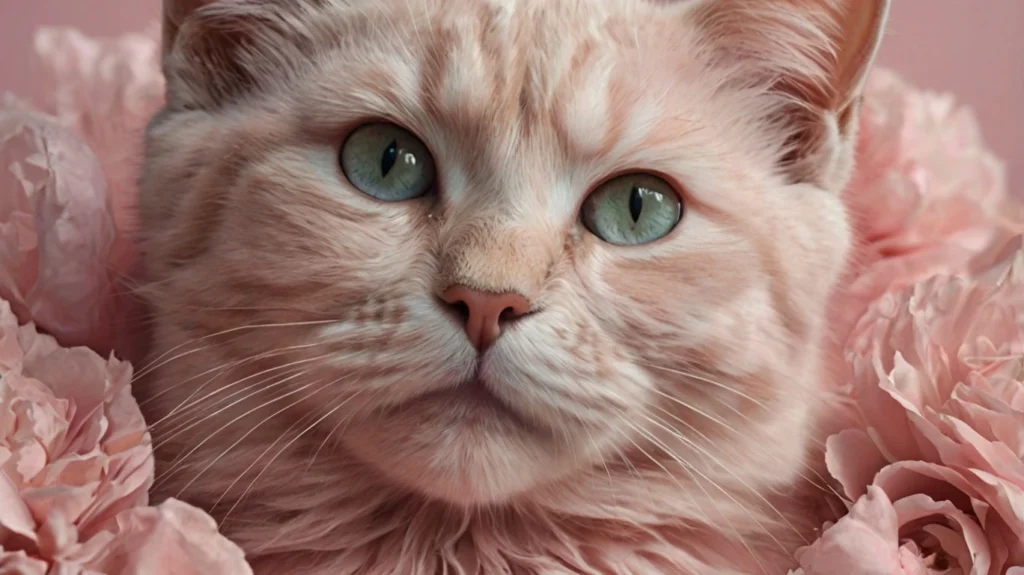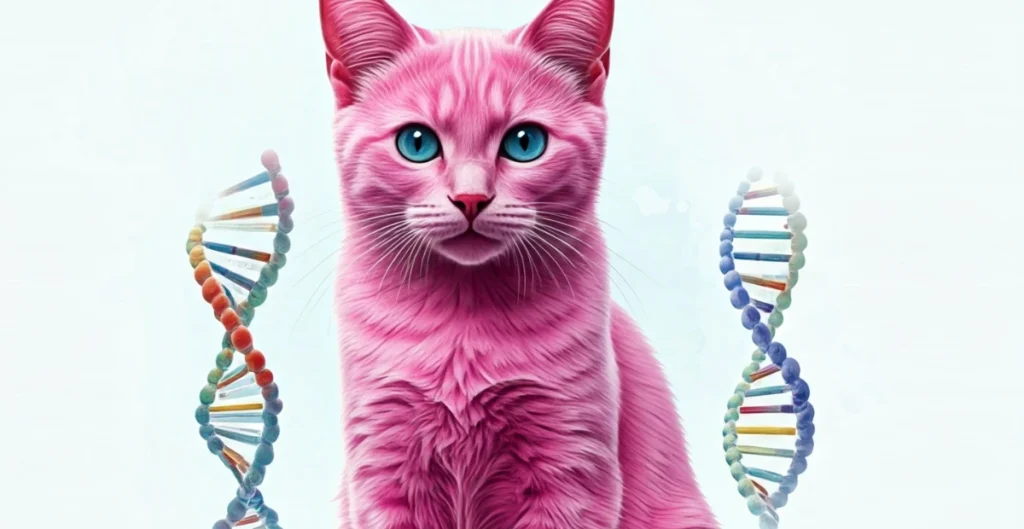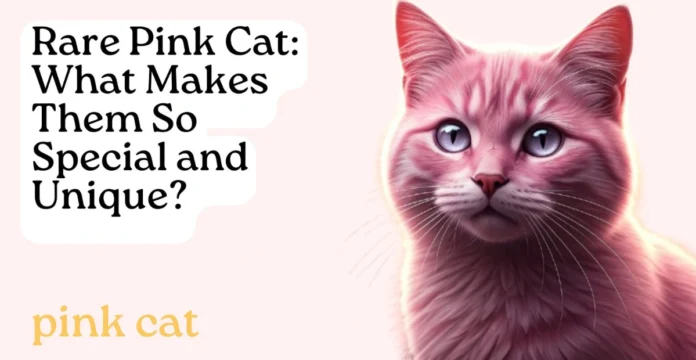Have you ever dreamed of having a pet that’s as unique as it is beautiful? Imagine a cat with fur that shimmers in soft, pastel pinks—something straight out of a fairy tale. But, what if we told you that these rare pink cats do exist? While pink cats may seem like a whimsical myth, they’re a rare and fascinating reality for those who are lucky enough to encounter them. In this article, we’ll dive deep into the world of pink cats, uncovering their origins, genetics, and what makes them so special. Whether you’re considering adopting one or simply curious about these mysterious creatures, this guide will give you all the insights you need.
advertisement
Table of Contents
What Exactly is a Pink Cat?

You’ve probably seen images of cats with extraordinary, unusual fur colors—cats with fur so unique that it’s hard to believe they’re real. When it comes to pink cats, it’s important to understand that they don’t occur naturally in the way some breeds may have specific coat colors. Instead, the pink hue that you see in certain cats comes from specific genetic factors, sometimes a mutation or even artificial dyeing.
Key Points to Remember:
advertisement
- Rare Phenomenon: Pink cats are either born with a genetic mutation that gives them an unusual hue or are dyed for aesthetic purposes.
- Genetic Mutations: Some cats have color changes due to rare genetic mutations that cause pinkish or pale-colored tones.
- Dyeing Techniques: In some cases, owners or breeders may choose to dye their cat’s fur for beauty or as part of an artistic expression.
But, how do these creatures get their signature pinkish tint? Let’s explore the science behind these rare pets.
The Genetics Behind Rare Pink Cats

Understanding the science behind pink cats involves looking at how their genes affect fur color. While cats don’t naturally come in a pink hue, genetic mutations can alter pigmentation and lead to unusual colors, including pale pinkish shades.
How Genetics Impact Pink Cats:
- Gene Mutations: Some cats experience genetic mutations in the genes responsible for pigmentation, resulting in lighter, softer hues that can look pinkish under certain lighting conditions.
- Pigmentation Process: Cats have different pigments in their fur, such as eumelanin (responsible for black or brown fur) and pheomelanin (responsible for red and yellow fur). A mutation can cause these pigments to interact in a way that produces pinkish tones.
You may wonder: how rare are these mutations? They’re not commonly seen but are more likely to appear in certain breeds. So, if you’re hoping to find a naturally pink cat, it’s important to know which breeds are more likely to produce these rare animals.
Rare Pink Cats and the Sphynx Breed
advertisement
Among the many cat breeds, the Sphynx stands out as one of the most notable when it comes to pinkish cats. Known for its distinctive hairless appearance, the Sphynx breed often has skin tones that give it a pinkish appearance, making it an ideal candidate for those hoping to own a rare, exotic pet.
Why the Sphynx is Associated with Pink Cats:
- Skin Tone and Pinkish Appearance: The Sphynx’s lack of fur reveals its skin, which is often pale and can appear pinkish. The color is more pronounced in certain lighting, which may lead to the illusion of a pink cat.
- Genetic Factors: The Sphynx is a breed that’s been specifically bred for its hairlessness, which makes it more likely to show off its skin tone, including pink hues.
If you’re hoping to adopt a pink cat, the Sphynx might just be your best bet. While their pinkish hue isn’t caused by dyed fur, their skin’s natural color often gives them an otherworldly appearance. But remember: not all Sphynx cats are pink, and the color varies from cat to cat, depending on the individual’s genetics.
Dyeing and Artistic Expression: How Pink Cats Get Their Color
Although rare genetic mutations can cause a cat to have a pinkish appearance, there’s also another route to achieving a pink cat: dyeing. Cat owners have long experimented with dyeing their pets’ fur for fun, aesthetics, or as a form of artistic expression.
Is Dyeing Cats Safe?
- Safe and Non-toxic Dyes: If done properly using pet-safe, non-toxic dye, it’s possible to change your cat’s fur color without harming them. However, this should never be attempted using human hair dye or any product not designed for pets.
- Ethical Considerations: While some people love to dye their cats’ fur for special occasions, it’s important to think about the ethical implications. Some people argue that dyeing animals for vanity is unethical, and animal cruelty laws prohibit certain forms of pet alteration. Always ensure that any dyeing procedure you undertake is safe and doesn’t harm the cat in any way.
For those who love to experiment with colors, a pink cat can be an artistic canvas. Just remember to do your research, follow safe practices, and always prioritize the well-being of your pet.
advertisement
The Fascination Behind Pink Cats: What Makes Them So Special?
You may be wondering why anyone would go through the trouble of owning a pink cat. After all, pink is a color typically associated with softness, innocence, and beauty, so it’s no surprise that these rare creatures hold such a strong appeal.
Why Do People Love Pink Cats?
- Rarity and Mystique: The idea of owning a pink cat is a dream for many pet lovers. Because these cats are so rare—whether naturally occurring or dyed—having one is like owning a piece of living art.
- Aesthetic Appeal: Pink, as a color, evokes a sense of calm, happiness, and creativity. For many, having a pink cat is not just about its rarity, but also about the positive emotional response it generates.
Emotional Connection: Having a rare pet like a pink cat often creates a deeper emotional bond between the owner and the pet. These cats are more than just pets—they become symbols of uniqueness and creativity.
The Appeal of Rare Pets: Emotional Connection and Cultural Impact
Owning a rare pet like a pink cat is more than just about having an unusual appearance. It’s about the emotional connection and the sense of joy that comes from owning something so extraordinary.
Cultural Impact and Social Media
advertisement
- Viral Sensations: In the age of social media, it’s easy for rare pets like pink cats to go viral. Their uniqueness makes them internet sensations, drawing attention from people around the world. Their videos and photos become shared widely on social media platforms like Instagram and TikTok, further increasing their appeal.
- Symbols of Status: Just like rare designer items or luxury cars, pink cats can become symbols of status. Owning one is a statement—a reflection of your taste, personality, and love for the unique.
Are Pink Cats Healthy and Ethical?
While pink cats are beautiful, you may have concerns about their health and the ethics of dyeing or breeding them. It’s important to think about the well-being of these animals before diving into the world of rare pink cats.
Health Considerations
- Skin Care: If you choose to own a pink cat, especially a dyed one, you’ll need to take extra care of their skin. Pink cats, particularly those with hairless breeds like the Sphynx, are more vulnerable to sunburn and need sunscreen to protect their delicate skin.
- Proper Grooming: Some cats, especially hairless ones, require frequent baths to keep their skin healthy. They also tend to accumulate oils that would normally be absorbed by their fur, so it’s important to clean them regularly to prevent irritation.
Ethical Considerations
- Breeding for Unusual Traits: Breeding for specific traits, including rare coat colors, can sometimes lead to health issues. Always choose ethical breeders who prioritize the health and well-being of their animals over profit.
- Dyeing Practices: While some people view dyeing a cat as a harmless form of expression, others argue that it’s not ethical. If you decide to dye your cat, always use safe, non-toxic dyes and ensure it doesn’t harm your pet in any way.
advertisement
Caring for a Pink Cat: What You Need to Know
Like any pet, pink cats require special care. From diet to grooming, there are certain aspects of their care that you’ll need to be aware of.
Key Care Tips for Pink Cats:
- Skin Protection: Whether you have a Sphynx cat or a dyed pink cat, it’s essential to protect their skin from the sun. Use pet-friendly sunscreen and provide shaded areas where your cat can relax safely.
- Regular Baths: Hairless cats or dyed pets require frequent baths to keep their skin healthy. Bathing helps remove oils and dirt that can accumulate on their exposed skin.
- Nutrition: A balanced diet is key to maintaining your cat’s overall health. Consider foods that support skin health and provide necessary vitamins and minerals for your cat’s well-being.
FAQ Section: Everything You Need to Know About Pink Cats
1. What causes a cat to turn pink?
- Pink cats are typically the result of genetic mutations or dyeing. Certain breeds like the Sphynx can appear pink due to their skin’s natural color, while others are dyed for aesthetic purposes.
2. Are pink cats real or just a myth?
- Pink cats do exist, but they are rare. While some cats naturally have pinkish skin, others are dyed for artistic reasons.
3. How do I care for a pink cat?
- Pink cats need special care, including sun protection, regular baths, and a healthy diet. Always prioritize their skin health and overall well-being.
Final Thoughts: Owning a Pink Cat
Owning a pink cat is a unique and rewarding experience. Whether you’re drawn to their rarity, their beauty, or their playful personalities, these cats stand out in any home. If you’re lucky enough to own one—or are simply fascinated by their existence—you’ll find that pink cats are more than just a pet; they’re a symbol of creativity and individuality.
Call to Action: Interested in bringing a rare pink cat into your home? Research your options, find reputable breeders, and ensure you’re ready for the care that these special pets require. Your pink cat could become the next viral sensation—or at the very least, your best friend for life.


